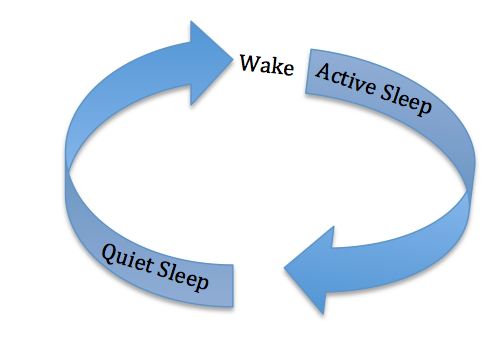Infants sleep a lot! On average, your infant can sleep between 16 and 18 hours a day. As a new parent, you may have noticed that this sleeping pattern is a lot different from yours. Unlike adults, babies do not have typical sleep patterns or schedules. Some infants sleep for a long time, while others wake up more frequently. Some sleep lightly, while others deeply. Every baby is different. You may feel frustrated if your baby keeps you up at night, yet can sleep for hours during the day.
Video with information about infant sleep patterns. // source: Today’s Parent, 2017
Babies do not understand the difference between day and night. Their external clock is not yet developed, which takes its cues from daylight and darkness. This means that your baby’s sleep patterns are not yet cued to the natural cycle of day and night. In adults, this external, master clock is located in the brain near your vision-processing areas. It manages your Circadian rhythms: your internal clocks, which play a role in controlling your 24-hour sleep and wake cycles. Rather, the life of a newborn revolves around getting fed. Their sleep patterns are shaped moreso by the time it takes to feed, digest, and become hungry again, rather than by night and day.
Although infants spend all of this time sleeping, not all of that time is in the same type of sleep. Babies go through stages of active and quiet sleep. Active sleep is a light sleep state, where you may notice your baby occasionally moving their arms or legs, smiling, sucking, fluttering their eyelids, and breathing more rapidly or irregularly than during quiet sleep. During quiet sleep, your baby may take slower, more rhythmic breaths, move less, and will not flutter their eyelids. An infant’s sleep cycle is only 50 minutes long, which is shorter than an adult’s 90-minute cycle. With this short cycle, your baby has more opportunity for arousal.

Finally, you may find yourself checking on your infant during the night in fear of Sudden Infant Death Syndrome (SIDS). SIDS is the unexplained death of a healthy baby while he or she sleeps. Although this may seems frightening, there are ways to help your baby sleep more safely and reduce their risk. See the supplementary material (5) for more information.
Newborn sleep patterns take a toll on parents, and you may begin to feel exhausted when trying to figure out your baby’s sleep schedule. Do not lose hope, even if you are losing sleep! Time is on your side. By four months, your infant’s external clock is starting to become linked to light cues, and by six months your infant’s sleep period lengthens to about six hours during the night. You may find it difficult to get a full nights sleep, but sleeping when your baby sleeps and adapting to your infant’s sleep schedule can help you adjust as best as you can.
Supplementary Material
For additional information and resources, take a look at the following.
1. Infants have not yet developed a normal adult Circadian rhythm. If you are interested in learning more about Circadian rhythms and biological clocks, check out this link.
2. Feeling frustrated about losing sleep while adjusting to your newborn’s sleep patterns? You’re not alone! Check out this blog post in The New York Timescontaining advice for new parents.
3. Did you know there is an app that turns your Apple device into a baby monitor? Place one device with your infant, and watch live video, talk, and receive alerts on your device. The app has several other features, which you can learn about here!
4. As your infant is developing, their patterns and schedules will start to shift and becoming more regular. This video provides helpful advice on establishing good sleeping habits for your newborn.
5. It is important to educate yourself about the causes and risk factors involved in Sudden Infant Death Syndrome (SIDS). Learn more about what you can do to help prevent it. These steps suggested by Mayo Clinic may help your baby’s small risk of SIDS become even smaller.
References
Mayes, L. C. & Cohen, D. J. (2002). The Yale Child Study Center Guide to Understanding Your Child: Healthy Development from Birth to Adolescence. Boston: Little, Brown, and Company.
Mirmiran, M., Maas, Y. G. H., & Ariagno R. L. (2003) Development of fetal and neonatal sleep and circadian rhythms. Sleep Medicine Reviews, 7(4), 321-334.
Task Force on Sudden Infant Death Syndrome. (2011). SIDS and other sleep-related infant deaths: expansion of recommendations for a safe infant sleeping environment. Pediatrics, 128(5), e1341- e1367.